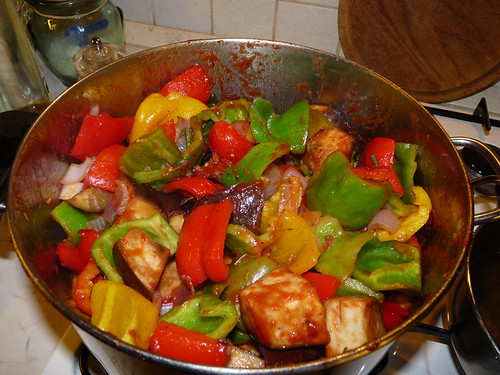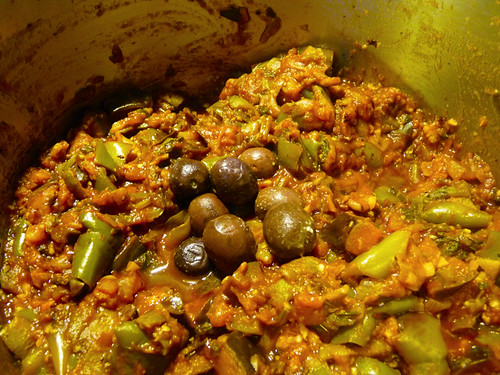- 6-8 small zucchini (the round ones) or 3-4 regular long ones. chopped into cubes
- 1 huge onion, or 2 medium ones, diced
- ¾ of a head of garlic (about 8 cloves) chopped roughly (not crushed!)
- some celery (if in Malta, use the old fashioned “karfus” as it has much more flavour, leaves and all, if outside malta use regular celery, leaves included) chopped finely
- 1 large aubergine (or 2 small) chopped into cubes
- 6 medium sized green peppers (capsicum), or a mixture of red and green (if you really don't like the bitterness of green ones, use red ones, however the green ones sweeten up with all the other things!) chopped into 2cm squares (remove all white pith!)
- Kunserva, about 3 heaped tablespoons of it. If in Malta, there is NO substitute. If abroad, I guess tomato paste, or a can of tinned tomatoes/polpa** will do (about half-3/4 of a can).
- Extra virgin olive oil, vinegar, salt, pepper
- Olives, capers.
Heat some oil in a large heavy saucepan. I use a couple of teaspoons sprinkled over the pan with a good olive oil pourer. Please feel free to use as much or as little oil as you like
Sauté the zucchini until golden brown. This is the only vegetable i cook a little beforehand, as they make the Kapunata too watery if I don't do this. Remove from pan and place on kitchen towel to further absorb some of the liquid.
Add onions and a sprinkling of water to the pan, cover and allow to cook until they are translucent. As soon as this is done, add the garlic, aubergines, celery, zucchini and capsicums. Stir around, and then add the Kunserva and a maybe a quarter cup of water (do not add all of this water if you're using tomato polpa, it it's too dry you can add water after about 15 minutes), stir around again to ensure that all the vegetables are covered with the tomato. Season with salt and pepper to taste.


Reduce heat to absolute lowest (maybe even move it to the smallest burner on the stove), cover and simmer, stirring occasionally for about 1 hour.
If it gets way too dry, add a bit of water, but heaps of water comes out of the veggies so wait at least 15 minutes before doing this.
At this point, remove from heat and immediately stir in a tablespoon or so of vinegar, I always use Balsamic, however red or white wine vinegar is probably more traditional and does the job marvellously. I add a tablespoon of capers and a handful of olives at this point also. Feel free to add some chopped fresh parsley/basil also.
Allow to cool, then refrigerate. This dish is improved ten-fold just by allowing it to sit in the fridge for 24 hours before serving.
Serve with anything you like – from grilled fish/meat and boiled potatoes seasoned with parsley and olive oil, to a hunk of crusty Maltese bread, or for a simple lunch, just serve with some tuna/a hard boiled egg and some green leafy salad.
I've also used it as a mega chunky pasta sauce and it's simply to die for as the sauce base for a thick Maltese style pizza with goats/sheep's cheese and anchovies.
- Veggies all over are sprayed pretty extensively with pesticides unless you buy certified organic. Make sure you wash veggies well, I have been told that soaking them for a short while (10 min or so) in water with a dash of Apple Cider vinegar and a teaspoon or 2 of sea salt is helpful in removing some of these nasty chemicals.
- If I don't have Kunserva, and use polpa, i like to cook it a little before adding the water. Also add about a teaspoon of sugar, and an extra pinch of salt.
- Sometimes I add more tomatoes, especially if i'm going to serve it with pasta or on pizza.
- And some other times, I make a ridiculous amount, it freezes well, and also lasts for about a week or even more in the fridge (unless you eat it for breakfast lunch and dinner which is what I do sometimes :P)



I already prepared this kaponata twice since you posted it! I like it a lot and it's perfect on those days of my diet that I can eat as much veggies as I want!
ReplyDeleteIn central Spain (Castilla-La Mancha)the food called Pisto closely resembles Ratatouille.
ReplyDeleteIn Catalunya and Majorca there are slight variants called Samfaina and Tumbet respectively.
In Catalunya sometimes with fries or rice, as accompaniment of other meat-based meals.
In Majorca it's almost exclusively used as accompaniment of pork or fish-based dishes, depending on the season.
I’ve been making kapunata as per this recipe for more than 10 years! Absolutely the best recipe, traditional taste and easy to put together. This dish always brings back memories from my holiday in Malta and Gozo
ReplyDelete